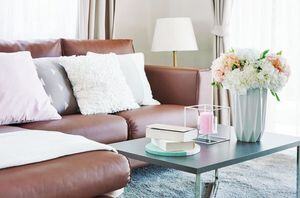Vibrant, hardy plants brighten any space and have the added benefit of purifying the air in your...
10 ideas for a Pet-Friendly Home
Your pet is part of your family, so make sure your furry friends feel like they’re also part of your home. Here are 10 ideas for pet-friendly home.
.jpeg?width=300&height=198&name=198%20(64).jpeg)
Remove temptation
Dogs and cats have a powerful sense of smell, so they’re drawn to fragrant items and places, which could include your garbage, pantry, and countertops. Keep a strong lid on your trash can and keep food out of the reach of pets. Remember, certain foods are toxic to dogs and cats, like grapes, raisins, chocolate, onions, mushrooms, and xylitol (artificial sweetener). In addition, a dog can choke on small bones discovered in a trash can.
Get rid of dangerous plants for pets
Some common house plants present a risk to pets, who often can’t resist chewing on foliage. English ivy, lilies, azaleas, mums, tulips, and oleander should be removed from any areas where your pets roam freely. Click here to browse the ASPCA’s complete list of toxic plants.
Another reason to put down the toilet lid
The toilet bowl is a curious place for animals. Dogs and cats may go there for a drink, and end up ingesting chemicals. Small animals—hamsters, kittens, guinea pigs, gerbils—have been known to fall in and drown. For safety sake, make sure everyone in your family closes the toilet lid.
Tuck strings, cords, and wires out of reach
Animals may chew or become tangled in the cords from your electronics or window treatments. Protect your animals and your home by keeping those pet hazards out of reach.
Put a latch on cabinets
Cabinet doors can be easily opened with the nudge of a nose or paw. Prevent your pet from getting into your stash of cleaning supplies by putting a child-safe latch on your lower cabinet doors.
Secure your screens
Cats and dogs love to look out windows. They might get a little too excited when they spot a squirrel or bird. If your window screen isn’t firmly secured, your cat or small dog can push the screen and fall out the window. Check your window screens to make sure they are tightly secured.
Provide safe chew toys and scratching posts
It’s natural for dogs to chew and cats to scratch. Cats mark territory with scent from glands in their paws and also scratch to sharpen their claws and stretch their muscles. You can prevent them from taking out their natural instincts on your furniture, flooring, door trim, and windowsills by presenting palatable alternatives. Put healthy chew toys in various places for your dog. Place scratching posts and boards (preferably with coarse surfaces, like sisal rope) near the areas where you cat likes to scratch. Rub catnip oil on the scratching surface to entice the cat.
Give them their own space
You have your bedroom, so why not give your dog or cat their personal space? A dog bed with toys and perhaps a blanket with your scent on it is perfect for your canine companion. Cats prefer to hide away in a secluded space, so a quiet retreat away from bustling activity will be ideal. A perch on a windowsill is also a welcomed space for a cat to relax.
Shop wisely for home furnishings
Be sure your upholstery and carpets are stain-resistant and sturdy. Avoid anything with a thick nap or pile because pet hair will find its way in there and become difficult to remove. You might also consider purchasing furniture that blends in with your pet’s fur color!
Top your bed with washable duvet covers
A majority of homeowners welcome their pets into their beds. A duvet cover is easy to remove and wash—and far less bulky that a comforter.
When you create a safe environment for your pet, you’re less likely to have those “oh no!” moments.
.jpeg?height=200&name=198%20(15).jpeg)

.jpeg?height=200&name=198%20(6).jpeg)